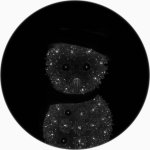Had this idea while reading and writing in a thread about the advances in camera technology and the flip side of what you can do with less.
The very first consumer camera was a Kodak No. 1 and had a fixed shutter and an aperture. The No. 1 did not even have a view finder, but was aimed by just pointing the camera in the direction of the subject. It would take 100 exposures and then the user sent the whole camera to Kodak to have it developed and reloaded at a cost of $10 in 1889 ($200+ in today's money). The photos were 2 1/2” (65mm) round instead of rectangular or square.
What can you do (and what can you learn) when you don't have settings you can adjust to the conditions or an autopilot.
So, here's the challenge: Take one camera with a normal lens and set it up as a Kodak No. 1. Use any camera, even a cell phone, provided you can set it up manually as listed below.
Take 5 photos:
Post your 5 photos in this thread. You can post 1 at a time or all at once.
_______________________________________________________________________________
Note Below: The Kodak No. 1 had a 57mm Bausch & Lomb lens, so to get the same approximate field of view:
· For FX use 30mm +/-
· For DX use 20mm +/-
· For CX use 10mm +/-
Edited to add: Optional focus distance
Edited to clarify: No post that affects exposure
The very first consumer camera was a Kodak No. 1 and had a fixed shutter and an aperture. The No. 1 did not even have a view finder, but was aimed by just pointing the camera in the direction of the subject. It would take 100 exposures and then the user sent the whole camera to Kodak to have it developed and reloaded at a cost of $10 in 1889 ($200+ in today's money). The photos were 2 1/2” (65mm) round instead of rectangular or square.
What can you do (and what can you learn) when you don't have settings you can adjust to the conditions or an autopilot.
So, here's the challenge: Take one camera with a normal lens and set it up as a Kodak No. 1. Use any camera, even a cell phone, provided you can set it up manually as listed below.
- Use the same focal length for each shot. Option: Use the FOV equivalent. See note below
- Set aperture at f/9 or nearest. (The No. 1 lens was f/ 9)
- Set ISO at 100
- Set shutter speed at 1/100
- Optional: Set your focus distance to 10' (3 meters)
Take 5 photos:
- Use the same camera settings for all 5 shots.
- There must be at least 1 hour of time between each photo. Can be days, weeks or months, but has to be at least one hour.
- All lighting must be ambient, aka available light. No flash.
- At least one photo must be outdoors.
- At least one photo must be indoors.
- Post processing that affects exposure not allowed for the 5 images except:
- Optional: Converting straight to B&W.
- Optional: Apply a circle mat to the finished photos with minimal cropping.
Post your 5 photos in this thread. You can post 1 at a time or all at once.
_______________________________________________________________________________
Note Below: The Kodak No. 1 had a 57mm Bausch & Lomb lens, so to get the same approximate field of view:
· For FX use 30mm +/-
· For DX use 20mm +/-
· For CX use 10mm +/-
Edited to add: Optional focus distance
Edited to clarify: No post that affects exposure
Last edited:

